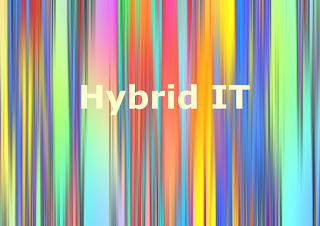“IT Innovation” Book Introduction Chapter 3 Renovate a Hybrid IT and Digital Organization
 We live in the world with both “old” and “new,” embracing digital is inevitable as that it is now part of reality. The latest enterprise digital computing technologies enable seamless virtual platforms, enhance physical organizational structures, empower workforce sharing the thoughts and ideas, engage customers and partners to voice concerns and feedbacks, and encourage the broader conversation and interaction within its business ecosystem. Either from management, technology or talent perspective, is hybrid the right way to move forward with the right speed?
We live in the world with both “old” and “new,” embracing digital is inevitable as that it is now part of reality. The latest enterprise digital computing technologies enable seamless virtual platforms, enhance physical organizational structures, empower workforce sharing the thoughts and ideas, engage customers and partners to voice concerns and feedbacks, and encourage the broader conversation and interaction within its business ecosystem. Either from management, technology or talent perspective, is hybrid the right way to move forward with the right speed? Being hybrid means to take balance as a management philosophy: In order to make a solid digital transformation, there are many seemly paradoxical, but indeed coherent elements in running a high-effective IT organization today. The balance is important in regards to making a strategic decision that delivers the real sustainable competitive advantage of an organization. From IT management perspective, hybrid IT capabilities work best to fit most organizations. Often, centralized or decentralized IT capabilities are the perpetual dilemma to optimize IT as a business enabler. The guidelines include centralize what makes sense from a decision-making perspective - strategy formulation, common and shared services like economies of scale and unification across the business, risk/disaster management. While technology provides new frontiers for work systems, there are also challenges with issues of human connectivity. The challenge is having a harmonized vision about overall IT management philosophy, capabilities, structures, and maturity in an IT organization, and develops the best and next practices in running IT as a business enabler and digital engine with the ultimate goal to bring high-performing result.
Organizational democracy: Organizational democracy will begin to become a fundamental management practice to update the hierarchical command-control systems. Organizational design needs to well reflect leadership competency; that democratic processes will overtake hierarchical control, and that culture will become a more fundamental organizational asset through the impact of digital/social technology. The digital computing technology enables seamless virtual platforms, enhance physical organizational structures, empower workforce sharing the thoughts and ideas, engage customers and partners to voice the concerns and feedback, and encourage broader conversations and interactions within its business ecosystem and social value change. A hybrid organizational structure can bring greater awareness of the intricacies and the systemic value of organizational systems, processes, people dynamics, technology, resource allocation, supply side variables, market variables, economies of scale, etc. People are the focal point of organizational democracy and a hybrid organization.
 Developing the hybrid solutions and practices to run digital IT: The pervasive digitalization or IT consumerization requires the balance of “old experiences” and “new way to do things,” the learning and doing.” The reach and range flexibility that now exists removes barriers that have existed in the past. The emergence of potential opportunities for exploiting digitization is likely to follow a nonlinear pattern or exponential speed, as the pervasiveness of an organization’s digitization journey increases. How these ideas are recognized, filtered and dealt with will become a crucial factor in an organization’s success in running a balanced IT and producing digitized products and services. It’s important to keep the balanced of IT stability and speed. To be successful, IT leaders need to support the existing environment and maintain the healthy application portfolio while deploying innovative value via taking value-added initiatives. IT-business alignment is moving into IT enablement and engagement. So perhaps more importantly, whether one believes that the current experience is a transformation or just an extension of the past, what are the things that you can do as IT and non-IT leaders to leverage the experiences of the past, and what are some new lessons for you to consider through applying digital technologies. The ultimate goal is to build a balanced, high-performing and customer-centric IT organization.
Developing the hybrid solutions and practices to run digital IT: The pervasive digitalization or IT consumerization requires the balance of “old experiences” and “new way to do things,” the learning and doing.” The reach and range flexibility that now exists removes barriers that have existed in the past. The emergence of potential opportunities for exploiting digitization is likely to follow a nonlinear pattern or exponential speed, as the pervasiveness of an organization’s digitization journey increases. How these ideas are recognized, filtered and dealt with will become a crucial factor in an organization’s success in running a balanced IT and producing digitized products and services. It’s important to keep the balanced of IT stability and speed. To be successful, IT leaders need to support the existing environment and maintain the healthy application portfolio while deploying innovative value via taking value-added initiatives. IT-business alignment is moving into IT enablement and engagement. So perhaps more importantly, whether one believes that the current experience is a transformation or just an extension of the past, what are the things that you can do as IT and non-IT leaders to leverage the experiences of the past, and what are some new lessons for you to consider through applying digital technologies. The ultimate goal is to build a balanced, high-performing and customer-centric IT organization.A hybrid IT organization can only be managed well by a “hybrid CIO.” The CIO of today must be a “whole brainer,” and be able to transition confidently between being strategic and tactical. It is critical to positioning oneself to be able to understand the business and become the trusted and strategic business advisor. A CIO has to be logical enough to plan, engineer and follow through, but more importantly, a CIO needs to be creative and persuasive in order to get their ideas approved and funded, and be innovative to lead high-innovative IT teams. A logical mind can follow directions, a creative mind can lead. Great CIOs must be great leaders, and if they are both logical and creative thinkers, that would make their leadership highly effective.
Follow us at: @Pearl_Zhu
Published on November 06, 2016 22:47
No comments have been added yet.



